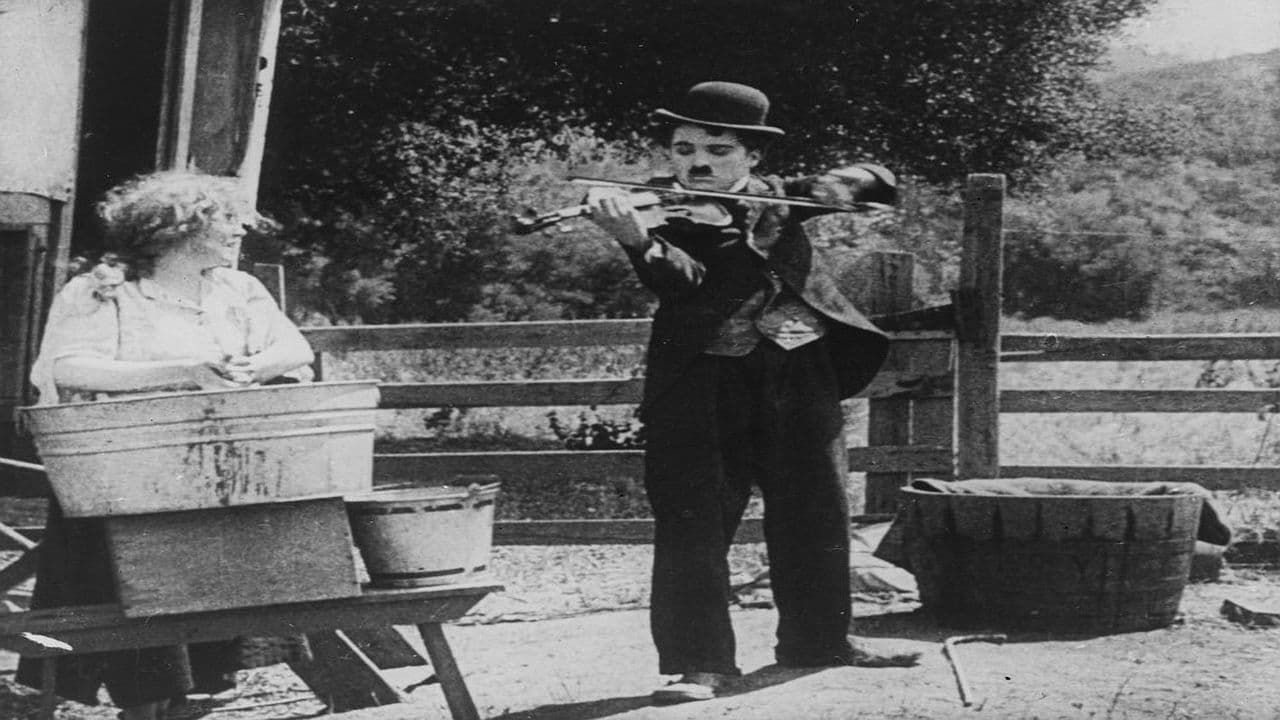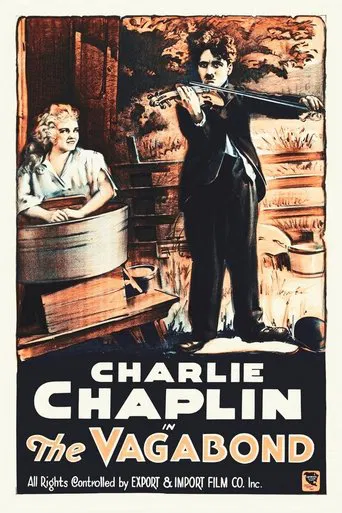

THE VAGABOND (Mutual Studios, 1916), directed by Charlie Chaplin, stars the legendary Charlie Chaplin in his third comedy short for the studio. With Chaplin's attempt with improving himself with each passing film, rather than the usual twenty minutes of slapstick and chases, he deftly blends humor and sentiment, a standard that would later become associated by his technique in storytelling. Rather than playing a trouble-making tramp, this time Charlie's a violin playing drifter with more human qualities than before.The story opens in great comedy tradition as Charlie enters a bar to play his violin for the patrons. His music is drowned out by a German street band playing outside. As the band leader enters to collect money, he finds Charlie collecting the money instead. A brawl and chase ensues until the crowd loses themselves in the confusion, giving Charlie a chance to sneak away. Charlie next approaches a gypsy drudge where he plays for a gypsy girl (Edna Purviance) washing clothes. A brief cutaway of the plot shows a society matron (Charlotte Mineau), looking at an old photo of a little girl who, believed by its movie audience to have been abducted by gypsies many years ago. Now a young woman, the girl is shown to be an abused slave to the gypsy leader (Eric Campbell). Witnessing one of her brutal whippings that leaves her senseless, Charlie steps in to rescue her, leading to a wild escape down the road in a gypsy caravan. Resting in a secluded spot on a country road, Charlie, having assisted the gypsy girl with her every needs, finds himself in stiff competition when a struggling artist (Lloyd Bacon) enters the scene, inspired by the girl's beauty and uses her as a subject matter to his latest canvas painting, "The Living Shamrock." THE VAGABOND may not be one of Chaplin's most memorable of his comedy shorts for the Mutual Studios, but it represents him here more as a comic-actor rather than a just a slapstick one. Though scripted by Chaplin himself, the story seems to have some influence to Michael Balfe opera, "The Bohemian Girl," which also involves gypsies. While THE VAGABOND could very well have become a straight dramatic story for the possible choices of a Lillian Gish and Robert Harron under D.W. Griffith's direction, instead, it's Chaplin being both Griffith and Harron, and Purviance being Gish. Because its a two-reel comedy, it leaves very little detail for plot and character development. There are moments found in the film where it looks heavily edited. Usually when comedians do drama, or mix comedy with drama, the attempt fails. Fortunately for Chaplin, his method is believable and acceptable as long as he doesn't stray too far from his usual standard of comedy. Of the Chaplin stock players, including Leo White and Frank J. Coleman, Eric Campbell, later known as "Chaplin's Goliath," stands out as the hefty villainous gypsy with the whip, while the funniest performance comes from a character playing an old white-haired gypsy hag. No screen credit is given for his or her work. If played by an actor in drag, all the funnier. And the young artist, played by Lloyd Bacon, the same Bacon who would become a notable movie director himself.Presented on commercial television in the sixties as part of "Charlie Chaplin Theater," and unseen on public broadcasting television since the 1970s, THE VAGABOND was later resurrected a decade later on cable channels and home video. Though various editions have different underscoring, ranging from orchestration to jazz rhythm and blues, Blackhawk Video's edition consisted of reissue prints presented in theaters of the 1930s with the use of sound effects and instrumental scoring to "The Vagabond Lover" and theme scoring used for the independent feature, VANITY FAIR (Allied Pictures, 1932) starring Myrna Loy. When shown on Turner Classic Movies (TCM premiere: December 6, 1999) as part of its "star of the month" tribute to Charlie Chaplin, THE VAGABOND and other Mutual shorts were broadcast in restored clear visuals, new scoring and in accurate silent film speed extending the standard 22 minute short to 34 minutes. Though that's all well and good, poor scoring most of all takes away the enjoyment of the film, leaving the most preferred viewing from Blackhawk (later Republic) Home Video. Next Chaplin short: ONE A.M. (1916) (***)
... View MoreMonday September 10, 7:00 pm, The Paramount Theater, Seattle A clear departure from his work with Keystone and Essanany, Charles Chaplin's third production for Mutual Film Corporation, The Vagabond (1916) demonstrates a turn toward the more complex story development and balanced content found in early features such as, A Dog's Life (1918) and The Kid (1921).A saloon violinist (Chaplin) plays outside a small establishment, then solicits the patrons who mistake him for a member of the band also playing. He flees the ensuing altercation and discovers a waif, The Gypsy Drudge (Edna Purviance), held captive by cruel gypsies on a country road. He plays for her until the Chief (Eric Campbell) appears and beats them both. Charlie rescues the girl who is later discovered by a traveling artist. When her portrait is seen my her mother in a gallery the girl is rescued. Charlie is left alone, but the girl realizes her true love and returns for him.
... View More"The Vagabond" represents quite an evolution for Chaplin. He had already proved himself the funniest comedian on screen and was already in the process of distancing himself from the crude and frantic slapstick of Keystone. With this film, more than any afore, he recreated the tramp as a character worthy of pity. Here begins the pathetic hero whom audiences could invest their emotions in. At Mutual, adding this drama to his refinements in his comedy, he created in the tramp, cinema's most endearing and recognizable icon.In the film, the vagabond violinist saves the girl (Edna Purviance, as usual) from a terrible gypsy chieftain who whips her. Although Charlie saves her by hitting the gypsies over the heads with a log, there isn't much that's funny about this sequence; it's as purely dramatic as Chaplin's films ever get. And, it perfectly sets Chaplin up as the hero for the sentimental denouement. Additionally, rather than an equally rough and comic clown or a heavy as the tramp's competition for the girl, here, it's a handsome gentleman artist--leaving the tramp feeling inadequate--and to us, more sympathetic than ever.
... View MoreA pathetic fiddler tries to scrape a living together playing on the street and in bars. He chances upon a gypsy camp where he plays for a pretty young girl. However her father beats her savagely and the tramp helps her escape. When the pair happen upon a painter, events are set in motion to reveal the girl's true parentage.One of Chaplin's Mutual short films this shows him still developing the kindly tramp personae on film. As a result the humour is not yet fully developed although we do get one funny scene of people being hit over the head etc. The plot is as basic as above and is typical of the day - audiences wanted to see the poor people suddenly being elevated to better things, no matter what the device. However from modern views I wanted Chaplin to be funnier and the message to be toned down or at least be more realistic.Overall this will please fans of Chaplin and I think it is one of the first films he directed himself. The cast are good and it's always nice to see the little tramp act done well. However more routines and less aspiration would have been better.
... View More